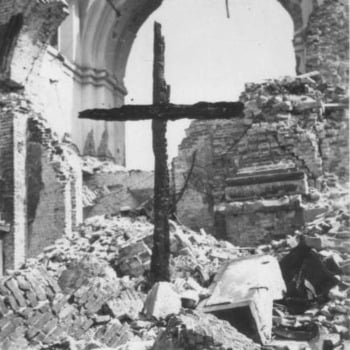-
 August 7, 2025By Alina Petrowa-Wasilewicz, OSV NewsWARSAW, Poland (OSV News) -- "Apparently, it is God's will that we die here," said Mother Janina Byszewska, the superior of the Benedictine Nuns of the Most Blessed Sacrament community, which found itself in the midst of the fighting of the Warsaw Uprising in August 1944.
August 7, 2025By Alina Petrowa-Wasilewicz, OSV NewsWARSAW, Poland (OSV News) -- "Apparently, it is God's will that we die here," said Mother Janina Byszewska, the superior of the Benedictine Nuns of the Most Blessed Sacrament community, which found itself in the midst of the fighting of the Warsaw Uprising in August 1944.
Shortly thereafter, 34 nuns, four priests and a thousand civilians died under the rubble of their own convent.
"People ask us if our sisters have been beatified," Mother Maria Blandyna, the current superior of the community, told OSV News. "No, because it is extremely difficult. All the documents, the monastery chronicle, were destroyed," she said.
The wartime story of the heroic nuns from Warsaw begins during the uprising in August 1944, when their convent became a site of both faith and tragedy. On Aug. 1, 1944, the Polish underground Home Army launched the uprising against the German occupiers, who had controlled the country since 1939. The resistance hoped to liberate the city before the Soviet Red Army arrived.
Fierce street fighting soon surrounded the Benedictine convent. On Aug. 6, the feast of the Transfiguration, one of the commanders asked the sisters to open the convent for use as a military base. The date is considered the beginning of their martyrdom that the sisters were well aware of.
The Benedictine convent has been founded by Queen Maria Sobieska as a votive offering of thanksgiving for the victory of her husband, King Jan III Sobieski, who in 1683 fought a decisive battle for Europe against the Turks at Vienna.
Queen Maria, who was French, invited the nuns from the congregation founded by Mother Mectilde of the Blessed Sacrament, born Catherine de Bar, based on the rule of St. Benedict but with an important innovation: The nuns were to adore the Blessed Sacrament continuously, to make reparation for insults and blasphemies, and in addition to the traditional vows, they took a fourth vow of perpetual adoration as a sacrifice.
By 1939, the convent was home to a remarkable group of women. Mother Tomea Koperska, the novice master, held a doctorate in philosophy and was an expert in St. Thomas Aquinas. Sister Anzelma Matuszczak studied Polish literature, and Magdalena Schmitz de Grollenbourg, the "funniest sister in the convent," was a music conservatory graduate. The community also included noblewomen such as Mother Byszewska and Mother Celestyna Wielowieyska, as well as the daughters of farmers, craftsmen, townspeople and even a sister born out of wedlock.
Sister Klara Zdrojewska, who struggled with reading and writing, was a mystic whose counsel the superior always sought. Sister Ignacja Rejewska had converted from Calvinism, drawn to the sacrament of confession as a path to spiritual growth.
As the battle raged, the sisters gave away their food and medicine, cared for wounded insurgents in a makeshift hospital, and continued their ceaseless adoration of the Blessed Sacrament. The Germans soon recognized the convent as a resistance point and bombarded it with incendiary and demolition bombs.
The sisters, known in Warsaw as heroic "Sakramentki" had the opportunity to evacuate earlier, but the commanders of the uprising asked them to stay and not take away the soldiers' hope.
Mother Byszewska agreed. "Apparently, it is God's will that we persevere and die here, in this position." It was their consent to death.
In fact, even before the worst days of the uprising -- reminiscent of hell in memories of those who survived -- arrived, the sisters had asked Mother Byszewska for permission to sacrifice their lives for Warsaw, for Poland and the world to belong to Christ.
It was not an easy request. Sister Katarzyna Kuzminska, to whom Christ appeared in a crown of stars and demanded this sacrifice from her, resisted terribly because she was afraid of death.
"Jesus demands a sacrifice from me, but I resist and am terribly afraid," the sisters recalled her saying. She is remembered as one eager for mortification, a hardworking and humble nun.
After 26 days under siege, they sensed the end was near. On Aug. 31, 1944, the Germans launched a final attack. The nuns descended to the basement with the Blessed Sacrament; some donned their solemn habits to meet Christ, their bridegroom, while Sister Teresa Tomaszewska calmly kept knitting, saying her work might still help someone after her death.
That afternoon, the beautiful Church of St. Casimir and the convent were reduced to ruins. The library of the monastery, holding 60,000 volumes, was burned to the ground. A story circulated in Warsaw that as the sisters perished in adoration, white doves rose into the sky. Thirty-four nuns, four priests and a thousand civilians died; only 12 sisters survived.
After the Germans retreated, the survivors immediately returned and began the arduous work of rebuilding. Today, residents of Warsaw, long convinced of the sisters' martyrdom, gather in the convent's rebuilt basement twice a year -- on Aug. 31 and Nov. 1, the feast of All Saints -- to pray for the beatification of the "Thirty-Four."
The convent;s archivist, Sister Maria Józefina, collects every little trace of the lives of the "Thirty-Four." Once, completely unexpectedly, someone sent Mother Tomei's doctoral thesis, while families keep sending photos and memories.
Mother Maria, today's tireless warrior to elevate Mother Tomei and her heroic sisters to sainthood, told OSV News: "Today's people, focused on themselves and their own affairs, need testimony of selfless sacrifice for others. This is a special sign for the modern world."
